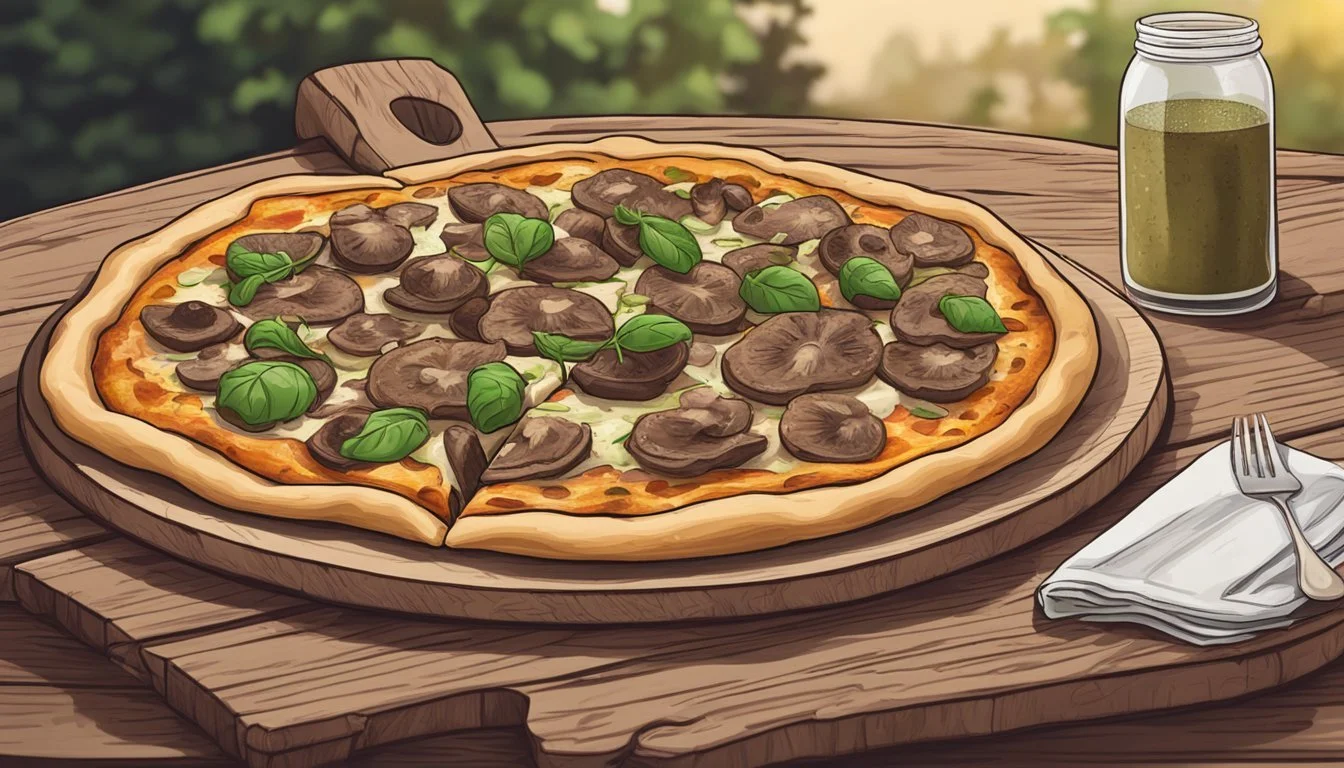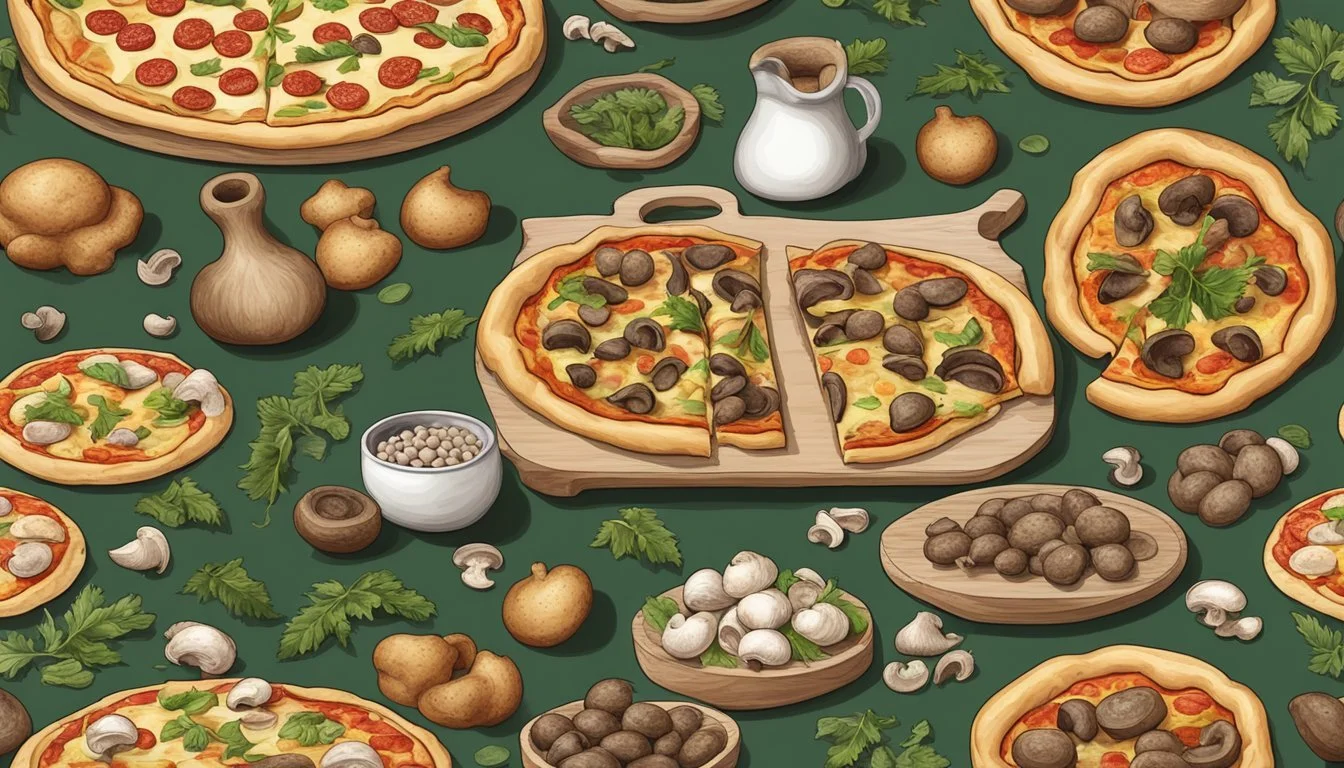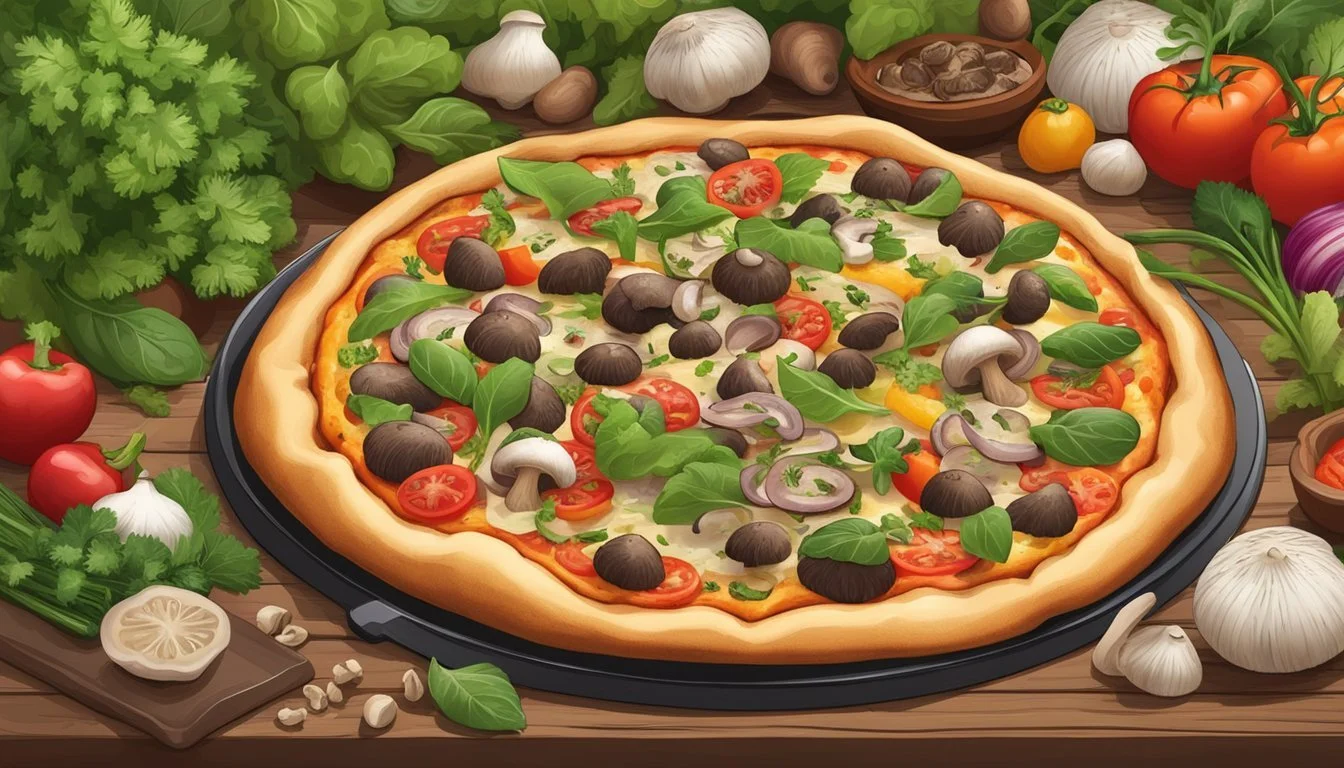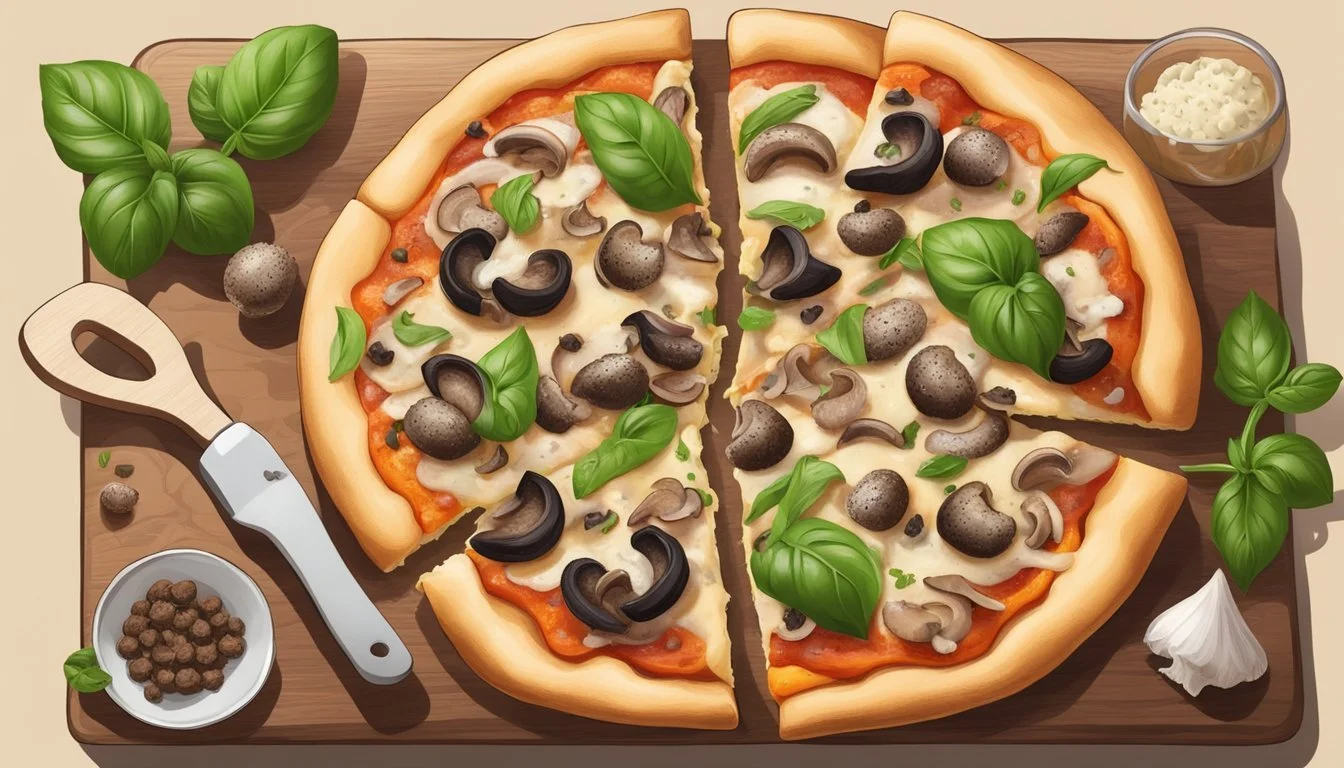Is Mushroom and Truffle Pizza Vegan?
Understanding Ingredients and Dietary Restrictions
Mushroom and truffle pizza can indeed be vegan, given that all the components - from the dough to the toppings - are made without animal products. Vegan pizza often substitutes dairy cheese with plant-based versions made from nuts, soy, or other vegan-friendly ingredients. The essence of a classic truffle pizza lies in the rich, earthy flavors (What wine goes well with earthy flavors?) that come from truffle oil or slices, which are naturally vegan. However, traditional pizzas use cheese and sometimes cream sauces, which are not suitable for a vegan diet.
For a mushroom and truffle pizza to be vegan, it's not just the exclusion of cheese that matters but also ensuring that the dough is free from ingredients like eggs or honey, which are sometimes used in pizza dough recipes. Incorporating mushrooms (What wine goes well with mushrooms?) into the mix adds a savory umami flavor, which complements the aromatic truffle, providing a gourmet experience that aligns with vegan dietary preferences. Many restaurants and recipes now cater to the growing demand for vegan pizza, innovating with toppings and methods to enhance flavor without compromising on dietary principles.
Truffles (What wine goes well with truffles?), a type of fungi prized for their distinctive fragrance, are paired with mushrooms to create a harmonious blend of textures and tastes that can easily be enjoyed on a vegan diet. When preparing or ordering vegan mushroom and truffle pizza, one must ensure that all ingredients, including truffle-infused oils or preparations, adhere to vegan standards. Specialty vegan establishments often explicitly state their compliance, while at standard pizzerias, it is advisable to confirm the ingredients to ensure that the meal is entirely plant-based.
Understanding Veganism
Veganism is a lifestyle choice that excludes all forms of animal exploitation and cruelty, particularly in diet, thus adhering to a plant-based meal plan. Vegans avoid meat, dairy, eggs, and any other products of animal origin.
When it comes to pizza, a traditional favorite, the fundamental difference in a vegan pizza lies in the absence of animal-based cheese and meat. Instead, vegan versions utilize substitutes like vegan cheese and plant-based toppings. Vegan mozzarella can be made from a variety of plant-based sources, such as nuts, soy, or roots like tapioca, providing a similar texture and flavor to its dairy counterpart.
Here are key components typically found on a vegan pizza:
Base: Usually composed of flour, water, salt, and yeast, which are inherently vegan.
Sauce: Marinara sauce, which is commonly vegan, made of tomatoes and herbs.
Cheese: Replaced by vegan cheese alternatives.
Toppings: Comprise a variety of vegetables, fruits, and legumes.
It's important to note that not all items with a veggie label are vegan, as they may contain non-vegan additives or byproducts. In the context of mushroom and truffle pizzas, the absence of animal products such as dairy cheese confirms their vegan status. However, they could contain hidden non-vegan ingredients like butter used in preparing mushrooms or truffle oil infused with animal-derived ingredients. Careful examination of the ingredients is essential to ensure that the product aligns with vegan standards.
Essential Pizza Ingredients
Crafting an impeccable mushroom and truffle pizza hinges on the choice of ingredients, ensuring that vegan alternatives align with traditional expectations in both flavor and texture.
Dough Composition
For the base, pizza dough encompasses a mix of flour, yeast, warm water, salt, and olive oil. While '00' flour is preferred for its fine grain and high gluten content, imparting elasticity, strong white flour serves as a suitable substitute. Proportions matter: for each cup of flour, a teaspoon of salt, a teaspoon of yeast, and a drizzle of olive oil create a balanced foundation.
Traditional Cheeses and Vegan Alternates
Mozzarella cheese is a staple due to its creamy texture and mild taste, but vegan mozzarella cheese, made from oils and plant proteins, offers a dairy-free option that melts similarly. Parmesan cheese adds a sharp, savory accent, while vegan parmesan, often derived from nuts and nutritional yeast, recreates this profile without dairy.
Sauces and Seasonings
Sauces add depth and moisture to pizza. While tomato sauce is common, featuring garlic, basil leaves, and oregano leaves, a white sauce can enrich the flavors, especially with a dash of garlic powder or minced garlic. Truffle oil is key, imparting a distinctive earthy aroma that pairs well with mushrooms.
Mushrooms and Truffles
Selecting the right mushrooms—from delicate cremini to meaty portobello—is critical. They should be sliced and often sautéed before topping the pizza. Wild mushrooms add variety and texture. Finely slicing or grating truffles over the pizza after baking ensures their signature flavor is preserved.
The Vegan Diet and Dairy Substitutes
When constructing a vegan pizza, a primary consideration is the exclusion of all dairy products, which includes traditional mozzarella cheese. The vegan diet strictly avoids animal-derived ingredients. Dairy substitutes play a crucial role in replicating the sensory appeal of cheese on pizza.
Cheese Alternatives:
Vegan Cheese: Available in varieties such as cheddar, gouda, and parmesan; composed of plant-based ingredients like nuts, soy, and root vegetables.
Vegan Mozzarella: Mimics the texture and meltability of its dairy counterpart, often made from coconut oil, tapioca starch, and nutritional yeast for a cheese-like flavor.
To craft the perfect vegan cheese topping, shoppers may choose from ready-made vegan mozzarella or make their own using nuts like cashews, blended with nutritional yeast, lemon juice, and various seasonings to achieve a cheesy flavor profile.
Dairy-Free Milks in Cooking:
Almond milk
Soy milk
Oat milk
Coconut milk
These milks can serve as a base for creamy sauces or as an ingredient in non-dairy buttermilk, where 1 cup of any non-dairy milk plus 1-2 tablespoons of apple cider vinegar substitutes for traditional buttermilk.
Ingredients Purpose Common Uses on Vegan Pizza Nutritional Yeast Cheesy Flavor Sprinkled as a topping or in sauces Coconut Oil Richness, Mouthfeel Cheese alternatives Tapioca Starch Meltability, Stretchiness Vegan mozzarella
In summary, vegan pizza enthusiasts can enjoy a fully plant-based pie with the use of these dairy substitutes that maintain the comforting, indulgent essence of pizza while adhering to vegan principles.
Preparing the Perfect Vegan Mushroom and Truffle Pizza
Creating a vegan mushroom and truffle pizza combines aromatic mushrooms, rich truffle flavors, and melty vegan cheese atop a crispy crust. This section guides the reader through crafting a flavorful vegan pizza from base to toppings, with clear baking instructions to ensure a golden, delicious finish.
Creating the Base
A good pizza starts with the perfect crust. Begin by activating dry yeast in warm water until it's frothy. Combine it with flour, a pinch of salt, and a touch of olive oil to form your dough. It's important to knead the dough until smooth and elastic, then let it rise until doubled in size. Preheat your oven with a baking stone or sheet inside to ensure an evenly baked crust. Roll out the dough on a floured surface to your desired thickness and transfer it to a heated baking stone or baking sheet with a sprinkle of cornmeal to prevent sticking.
Assembling the Toppings
For the toppings, select a variety of mushrooms to offer depth of flavor; slice them uniformly for even cooking. In a skillet, sauté the mushrooms in olive oil with minced garlic until they're tender and set them aside. Brush the pizza crust with truffle oil to infuse it with decadent flavor. Next, uniformly spread vegan cheese on the crust—it melts and binds the toppings together. Arrange the sautéed mushrooms on top and sprinkle with fresh basil leaves and oregano, granting a herbaceous note to the umami-rich mushrooms.
Baking Techniques
Baking is crucial for achieving the perfect texture in both the crust and toppings. Slide the pizza onto the preheated stone or sheet in an oven set at a high temperature, around 450-500 degrees Fahrenheit. This high heat mimics traditional pizza ovens and helps to create a crispy, golden base while melting the cheese to perfection. Bake for about 10-15 minutes, but keep a close eye—the pizza is done when the edges are a deep golden brown and the cheese is bubbling. Remove from the oven and let it cool slightly before slicing to allow the cheese to set. Enjoy every bite of your homemade vegan mushroom and truffle pizza, knowing it's crafted to perfection with every layer.
Serving and Presentation
When presenting a mushroom and truffle vegan pizza, one must consider the right way to cut and serve the pizza for optimal enjoyment. Garnishing, although a simple step, can drastically elevate the visual appeal and taste.
Cutting and Serving
For cutting the pizza into perfect triangles, a sharp pizza cutter or a long-bladed knife is essential. It is important to slice through the crust and toppings cleanly to avoid dragging the ingredients across the pizza. Serving is equally crucial; a pizza pan or a skillet with a spatula can be used for transferring the hot slices onto plates.
Pizza Pan: A sturdy pan helps in maintaining the shape of the pizza while cutting.
Skillet: A preheated cast-iron skillet can provide a crispy bottom crust.
Triangles: Cutting the pizza into even triangles ensures that each piece contains a bit of the delicious toppings.
Garnishing Tips
A drizzle of olive oil just before serving can add a hint of richness to the pizza. Basil leaves and fresh rosemary are excellent for adding both color and a herby freshness. A light sprinkle of black pepper or truffle salt can enhance the natural flavors of the mushrooms and truffle oil without overpowering them.
Herbs: Place basil leaves or chopped rosemary evenly across the pizza after slicing.
Truffle Oil/Salt: A sparing amount highlights the truffle flavor without making it too intense.
Pepper: Freshly ground black pepper adds a subtle spice that complements the mushrooms.
Vegan Pizza Variants
The versatility of vegan pizza allows for a myriad of mouthwatering variants, especially when featuring mushrooms and truffle oil. These pizzas can offer a complexity of flavors that appeal to both vegan and non-vegan palates.
Different Mushroom and Truffle Combinations
Mushrooms come in various types, each bringing its unique taste and texture that can be used in creating vegan pizzas. A wild mushroom pizza recipe might include a mix of shiitake, portobello, and cremini mushrooms for a rich, earthy flavor. One can enhance this blend with a few drops of white truffle oil to introduce a gourmet touch without animal derivatives.
Cremini provide a meaty bite
Portobello mushrooms offer a steak-like texture
Shiitake mushrooms deliver an umami flavor
White truffle oil: A drizzle enhances overall taste
For the base, chefs often select artisanal doughs seasoned with herbs like rosemary or thyme, which complement the fungi's flavor. The mushrooms are typically sautéed with onions and garlic to release their water content and concentrate their taste before being added to the pizza.
Creating a Flavor Profile
To craft a balanced flavor profile for a mushroom and truffle pizza, one should consider the interplay between the ingredients. The mushrooms should be caramelized to tap into their natural sweetness, counterbalancing the robust flavor of the truffles. Incorporating onions that have been cooked down until golden can add a note of sweetness, while a hint of garlic provides depth.
Sauté mushrooms with garlic to deepen the flavor
Caramelize onions for a sweet complexity
Use truffle oil sparingly to avoid overpowering
To finish the pizza, a drizzle of truffle oil just before serving can elevate the dish, infusing it with a distinct, aromatic character that makes the pizza indulgent yet wholly vegan. Paired with a vegan cheese alternative, this combination creates a satisfying ensemble that might be paired with a glass of wine, chosen to match the earthiness of the mushrooms and the heady notes of truffle.
Dietary Considerations for Vegans
When considering a vegan diet, it is crucial to examine the ingredients in dishes that are traditionally vegetarian, such as mushroom and truffle pizza. Vegans abstain from consuming all animal products, which necessitates careful selection when choosing ingredients for a pizza to ensure it aligns with their dietary restrictions.
Pizza Dough & Sauce: Typically, pizza dough and tomato sauce are vegan-friendly, containing basic ingredients like flour, water, salt, sugar, and tomatoes. However, one must verify that the dough has not been enriched with dairy or eggs, and that the sauce lacks cheese or meat-based flavoring.
Cheese Alternative: A pivotal ingredient for vegan pizza is vegan cheese. Traditional pizza uses cheese made from cow's milk, which is not suitable for vegans. Vegan cheese options are usually crafted from nuts, soy, or other plant-based ingredients.
Sea Salt: A simple yet significant element for enhancing the taste of vegan pizza is sea salt. Its addition can accentuate the flavors of toppings like wild mushrooms.
Wild Mushrooms: Mushrooms are versatile toppings that are inherently vegan. Wild mushrooms can introduce an umami depth to a vegan pizza without the need for meat or dairy products.
Vegetarian vs. Vegan: While vegetarian diets may include dairy or eggs, vegan diets exclude these. Every ingredient must be scrutinized, and assumptions should not be made based on vegetarian labels.
A consideration for pasta-based dishes is similar. Pasta is generally vegan, but one must ensure that no eggs were used in its creation. Accompaniments for pasta, such as sauces and cheeses, should also follow strict vegan criteria.
Using the above guidelines, vegans can enjoy a delicious pizza or pasta dish, provided they select suitable vegan alternatives for traditional non-vegan ingredients.
Frequently Asked Questions
When it comes to vegan diets, understanding the ingredients is crucial, especially with dishes like mushroom and truffle pizza. Here, one can find clarity on common inquiries regarding this dish's compatibility with veganism.
Can Vegans Eat Mushrooms and Truffles?
Mushrooms and truffles are both fungi, hence they are entirely plant-based and suitable for vegans. They do not contain any animal products, making them a popular choice for vegan dishes, including mushroom pizza. Truffle oil, often used to enhance the flavor of truffle pizzas, is typically vegan as it is usually a synthetic flavoring combined with olive or other vegetable-based oils. However, vegans should be mindful of the other ingredients used in a mushroom and truffle pizza, such as cheese and dough.
Mushroom Pizza: Typically consists of a base topped with tomato sauce, mushrooms, and cheese. For a pizza to be vegan, it must use dairy-free cheese.
Truffle Pizza: Involves adding truffle or truffle oil to the pizza. Vegans should ensure that the truffle flavoring is free from animal-derived ingredients.
Cheese: Vegan versions of pizza utilize plant-based cheese made from nuts, soy, or other vegan alternatives to dairy.
Dough: While pizza dough is commonly vegan, as it’s made from flour, water, yeast, and salt, vegans should confirm that no non-vegan additives, like dairy or eggs, have been mixed into the dough.
It’s always advisable for vegans to verify the ingredients of each component of the pizza to ensure they all align with vegan standards.
Conclusion
Mushroom and truffle pizza can be vegan, provided the ingredients used in the preparation are derived from plant-based sources. Vegan pizza typically substitutes dairy cheeses with plant-based cheeses made from nuts, soy, or other vegan-friendly components. When creating a mushroom pizza for vegans, one would ensure that the dough is made without eggs or dairy products, and that the toppings, including mushrooms, do not contain any hidden non-vegan ingredients.
In instances where truffle pizza is being prepared, it is crucial to use vegan truffle oil instead of butter-based truffle infusions. The pizzas mentioned in the search results highlight the use of vegan truffle oil, along with other vegan-friendly ingredients such as tomato purée, vegan parmesan, and shredded vegan mozzarella.
For those concerned about the authenticity of flavors, vegan pizzas can still deliver the rich umami taste that mushrooms and truffles are known for. The key is in the quality of the vegan ingredients and the preparation method which can result in a savory, delicious pizza experience sans animal products.
Below is a concise checklist for ensuring a pizza is vegan:
Dough: Made without eggs or dairy
Sauce: Tomato-based or using vegan cream substitutes
Cheese: Plant-based options such as nut cheese or soy cheese
Toppings: Fresh vegetables, including mushrooms and use of vegan truffle oil
Individuals can indulge in a vegan mushroom and truffle pizza with confidence in its vegan status when the ingredients have been vetted for animal derivatives. The market offers an expanding array of vegan products suitable for recreating classic comfort foods in a plant-based iteration.










